Originally released for the PC earlier this year, Jedi Knight II: Jedi Outcast marks the second time that LucasArts' Dark Forces series of first-person shooters has been released for a console--the first time being the mediocre port of Dark Forces for the PlayStation. The game was released in 1996, and it was plagued by sloppy controls and graphics that were, to put it bluntly, ugly. It was a stark contrast to the PC version of Dark Forces, which was one of the most memorable first-person shooters of its time, as the rest of the games in the series have been. Thankfully, the Xbox version of Jedi Outcast doesn't follow the trend of bad ports that Dark Forces for the PlayStation threatened to start. Instead, Jedi Knight II: Jedi Outcast for the Xbox is a great port that retains the essence of what it must feel like to be an all-powerful Jedi, which was so well conveyed in the original PC game, without sacrificing much in the way of graphics, playability, or overall value. In fact, the game's complicated control scheme is better served on an Xbox controller than it is in the PC's typical mouse and keyboard setup. Developer Vicarious Visions, which has been responsible for the Tony Hawk's Pro Skater games for the Game Boy Advance in the past, handled the porting duties for this Xbox version, and as Star Wars fans will come to find out, the company did a great job with it.
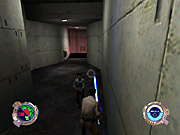
As far as the single-player component of Jedi Knight II: Jedi Outcast is concerned, the game is unchanged from its PC cousin. You are cast in the role of Kyle Katarn, a gruff mercenary who lends his smuggling skills to the Rebellion during its uprising against the Empire. Katarn has a storied past that has been well chronicled in the original Dark Forces and its sequel, Jedi Knight, and fans of the series will be glad to know that his moody manner and subtle pessimism remain intact in Jedi Outcast. The force is strong in Katarn, and he's no slouch with a lightsaber either, but after nearly falling to the dark side during the events of Jedi Knight for the PC, he's chosen to shun his Jedi ways in order to return to his life as a smuggler and mercenary for the Alliance. The game opens with Katarn and his trusty pilot, Jan Ors, on one such mission. They receive an urgent call from Mon Mothma telling the pair to investigate a distress call from the surface of a planet that was thought to be uninhabited. There, Katarn and Ors uncover a plot by the remnant Imperial forces to create an army of dark warriors who are technologically infused with the force.
In your quest to put a stop to this army of cybernetic soldiers, you'll fight your way through 25 single-player levels that span eight different environments, one more than the PC game. The Xbox version of Jedi Knight II includes the level that was found in the PC demo but wasn't available in the actual PC game itself. The single-player campaign is relatively long compared with the single-player modes in recent shooters, and it's also quite tough at the default difficulty level. Fortunately, like in the PC game, you're allowed to save anywhere, at any time. Some of the exotic locales you'll visit, like Yavin and the cloud city of Bespin, will be very familiar to Star Wars fans. Other levels are quite new, such as a mining facility on Artus and the innards of a massive capital ship called the Doom Giver. You'll also run into many new faces, as well as a handful of familiar ones who will undoubtedly please fans of the source material. Included in this notable cast of characters are Luke Skywalker and Lando Calrissian, the latter voiced by none other than Billy Dee Williams himself. The story in the original PC game was moved along through the use of good-looking prerendered cinematics, as well as in-game cutscenes that tended to focus close in on characters' faces, most of whom made use of believable facial animation and lip synching. That's why it's strange to note that, while all of the original prerendered cinematics have been retained in the Xbox version of the game, all of the in-game cutscenes have been changed to poor-quality full-motion video sequences. It's as though the developer took the existing in-engine scenes and encoded them with a bad compression value. Whether this was done for technical reasons or to give the game a single, continuous style of cutscene is unclear, but Jedi Knight II would have been better off without this inexplicable change.
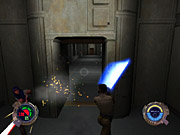
However, if you haven't played the PC version of the game, you probably won't even notice the change in cinematic quality, especially since your attention will likely be focused on the game proper. As you progress through the single-player missions, you'll encounter swarms of angry rodians and other assorted bounty hunters. And stormtroopers--lots of them, especially during the first five missions. In fact, save for a handful of interrogation droids and a pair of AT-STs, the only enemies you'll run into at first are stormtroopers, and the repetitive task of gunning down these white-clad soldiers will quickly wear thin. Kyle doesn't start the game with any force powers, nor does he initially have his lightsaber. Instead he'll usually be stuck with the Imperials' own inaccurate assault rifle. Furthermore, the first levels of Jedi Outcast are practically brimming with key-hunt puzzles and platform-jumping challenges. While there's a third-person view to help you time such jumps better, you'll invariably get frustrated early on at having to do so much jumping around, all for the sake of opening a door. Your gun-toting enemies will also exhibit some strange behavior during these early stages.
If you can weather the first few hours of Jedi Outcast, you'll note that it takes a sharp turn for the better. Suffice it to say that Kyle regains his force powers and lightsaber, the combination of which makes for some very satisfying and original action. There's nothing quite like walking into a room of stormtroopers and sending them all crashing to the floor with a force-filled flick of your wrist or fending off a cantina full of pistol-wielding drunks with nothing other than your lightsaber. The game departs from the RPG-like, open-ended character-advancement system found in Jedi Knight for the PC. In Jedi Outcast, you'll earn your force powers linearly. Every time you complete a mission, you'll be imbued with a specific new set of force powers, and as you progress through the game, your existing force powers will increase in strength. Each of your force powers has three levels, and by the end of the game, you'll be doing backward flips onto catwalks, choking the life out of bad guys before tossing them off ledges, sending arcs of searing electricity from your fingertips, and generally feeling like a bona fide Jedi master.
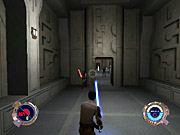
The game has eight force powers, most of which are taken from Jedi Knight. New powers include a Jedi mind trick that confuses enemies and causes them to do things like shoot their comrades and open locked doors for you, as well as force speed, which causes everything and everyone around you to move in slow motion in an effect that's very similar to bullet time in Max Payne, only Kyle continues to move at normal speed while his foes are trapped in slow motion. The game's default control scheme makes accessing these force powers much easier than it was in the original PC version. You can cycle through force powers by pressing up repeatedly on the D pad, and you can activate any selected power by pressing down on the left analog stick. And besides the lightsaber and the force powers, you'll also find a number of new weapons as you proceed onward, some of which are extremely powerful. But you'll have so much fun using your lightsaber and force powers that you'll rarely have the desire to use any of the game's other weapons. Actually, this works to the game's advantage, since it's easier to attack with a lightsaber using the controller's dual analog stick setup than with any of Katarn's ranged weapons. In the lightsaber mode, Jedi Knight II seems better suited on a console than it does on a PC, though it should be noted that, unlike the PC version, the Xbox version of the game doesn't let you switch to a first-person view when you have your saber equipped.
Regardless, the lightsaber is excellent--never before has melee combat in a shooter been so effectively executed. In addition to gaining force powers, Kyle is also able to advance his lightsaber technique. When you first get your saber, you can block a certain percentage of incoming shots with your saber automatically. You can also throw it in an arc like a boomerang. As the game progresses, these two skills will improve so that at their fullest potential, you'll be able to deflect virtually all blaster fire and actually control the saber as it weaves through the air. Beyond that, the saber combat in the game is surprisingly deep. The type of swing that Kyle takes is dependent on his movement direction and the location of the nearest enemies. So if an enemy is behind you, and you hit the backward key as you swing your saber, Kyle will stab backward. Time your strike at the apex of a jump, and Kyle will swing his saber downward in a deadly arc.
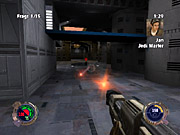
Kyle can also use three different combat stances while holding the saber, though you start with only one, and it appears that this gameplay mechanic too has been changed somewhat from the PC version. This initial stance lets you inflict a decent amount of damage and string together up to five moderately fast slashes by properly timing your button presses. Later in the game, you'll learn the fast stance, which lets Kyle strike quickly and string an infinite number of attacks together, though the strikes do less damage. Finally, you'll learn the strong combat style, which uses slow swings that do a considerable amount of damage but leaves you wide open for a counterattack.
A handful of stormtroopers or bounty hunters won't stand a chance against you once you've mastered your force powers and lightsaber. But as you make your way through some of the later levels, you'll start running into dozens of enemies at once. The game gets very tough, and dependence on any single aspect of your arsenal--weapons, force powers, or lightsaber--won't get you very far. You have to find the proper balance between all three, or at least between your force powers and saber. And even if you learn to handle roomfuls of enemies at once, the game will keep you on your toes by pitting you against a series of bosses, all of whom carry lightsabers and are well trained in the ways of the force. While some of the enemy AI of the stormtroopers is impressive--they retreat when taking losses and try to flank you when possible--it's combat with these saber-wielding enemies that's the most memorable aspect of Jedi Outcast. It takes only a second or two to dispatch a stormtrooper, but it can take up to a minute of nonstop combat to defeat a single one of these dark Jedi. Some of the more heated matches will have you locking sabers with enemies, frantically pushing the attack button to overpower them like in the classic fighting game Samurai Shodown.
Jedi Outcast was developed using the Quake III: Team Arena engine, which is based on the technology that has powered a number of memorable PC games like Star Trek: Voyager Elite Force and Soldier of Fortune II: Double Helix. In fact, some of the earlier levels in Jedi Outcast resemble those of Elite Force, though the overall look and design of Jedi Outcast's levels are far superior. Many of the levels are simply massive and constantly remind you that you're in the Star Wars universe. The original PC game suffered from occasional slowdown whenever the action picked up, and the Xbox version of Jedi Outcast suffers from the same problem. Most of the game, however, runs fairly smoothly, though nowhere near 60 frames per second. All the character models are sufficiently detailed--particularly the stormtroopers, who feature very sharp textures, plenty of detail, and subtle but effective reflections on their glossy armor. The environmental effects are also impressive. Your lightsaber leaves a scorch mark on any surface it touches and sometimes cleanly slices off the limb of a victim, and in one area, raindrops fizzle and evaporate when they make contact with it. Overall, the game has a somewhat dark and grainy look to it that its original PC cousin didn't share, but like with its reworked cutscenes, if you never played Jedi Knight II on the PC, then you probably won't notice these changes.
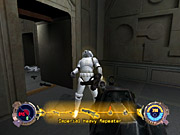
As you'd expect, the music in the game consists of the famous John Williams score featured in most other Star Wars games, though the music in Jedi Outcast is dynamic, so you'll hear it swell up during combat and then quiet down in between fights. Likewise, the sounds of blasters and lightsabers are done very well, though for better or worse they're the same effects that we've been hearing for more than 20 years. The voice acting is superb, and Katarn's gruff demeanor really shines through during the speech. What's more, the Xbox version of the game also supports surround sound, and if you have your console hooked up to a receiver capable of decoding Dolby signals, sound effects like shots and explosions will quite literally erupt all around you.
The single-player game in Jedi Outcast is easily worthwhile, though there's also a lot to the multiplayer mode, which, surprisingly, has retained all of the options from its PC cousin. There are seven basic gameplay modes available, and while most of them are just slight variations on the deathmatch, team deathmatch, and capture-the-flag options that you'll find in other games, they make excellent use of the Star Wars source material. Multiplayer Jedi Outcast takes an interesting approach to the use of force powers. Before starting any match, you're given a certain number of points that you can assign to any force power you want. High-level powers cost more points than low-level powers, and you can either spread your points among a wide range of low-level powers or focus them on a smaller number of potent ones. You'll have to choose carefully, because in addition to the eight single-player force powers, the multiplayer game of Jedi Outcast has seven extra powers, most of which are designed with teamplay in mind--powers like team heal and team energize.
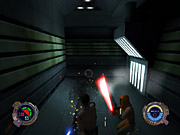
In all, there are 15 multiplayer maps, the majority of which are unique to Jedi Outcast's multiplayer mode and are not just slight enhancements of single-player levels. Unfortunately, the game doesn't make use of Xbox Live, and all of these multiplayer maps and modes have to be played either with bots or via split screen with a buddy. For what it's worth, though, each of these bots (there are 28 of them, all based on single-player characters and enemies) has his or her own set of characteristics that include accuracy and aggressiveness. Jedi Knight II seems like a clear candidate for Xbox Live, and it's somewhat disappointing that LucasArts opted not to support the service with this game.
Jedi Outcast isn't without a few shortcomings--the game starts off slow and involves a little too much puzzle-solving for a first-person shooter, and compared with other Xbox action games, its graphics aren't exactly mind-blowing. However, the game's strong points--especially its combat--overshadow whatever problems Jedi Outcast may have early on. It's a very fun game that borrows the best elements from past shooters, introduces a number of its own great twists, and then combines these elements to make something that will be highly enjoyable both for those who like shooters and those who simply like Star Wars. And if you happen to like both, then you'll be especially impressed. Jedi Outcast certainly becomes tough later on, but once you learn to master all your force powers and get a good grip on your lightsaber, you'll feel unstoppable--the sight of Katarn effortlessly cutting through, leaping over, and pushing back crowds of enemies is a sight to behold. Between Frontline, Buffy, Splinter Cell, and Hitman 2, there's been no shortage of action games for the Xbox in the past year, and Jedi Outcast is certainly one of the better ones to grace Microsoft's console.